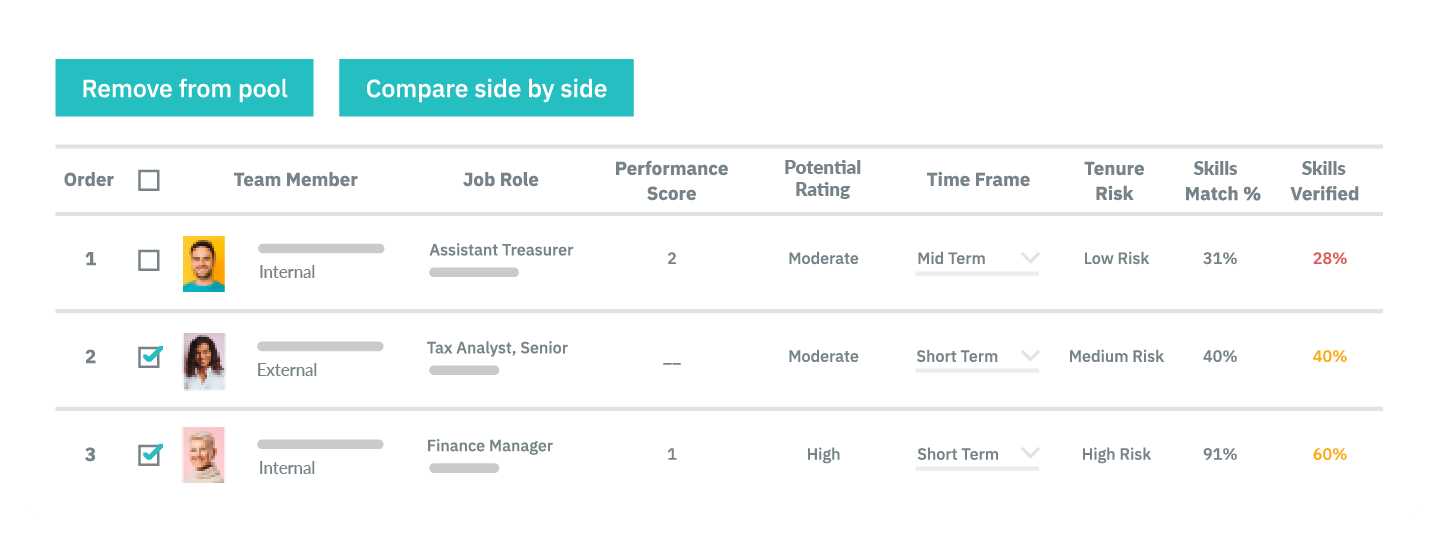Implementing Talent Assessment Software
The Need for Clean Data

Implementing talent assessment software is more than just incorporating a new tool into your organization’s processes; it’s about transforming the way you evaluate, develop, and position your workforce for success. At its core, talent assessment software provides a structured way to gain real-time insights into the strengths and developmental needs of your employees. These insights allow companies to make informed decisions regarding promotions, succession planning, and skill development, driving employee growth and aligning talent with business goals.
When organizations lack a structured approach to assessing talent, they often find it difficult to implement effective development plans or identify high-potential employees. By integrating talent assessment software, businesses can streamline the process of tracking and enhancing employee skills. This software automates the assessment of competencies, providing a comprehensive view of employees’ abilities and pinpointing areas for growth. However, implementing talent assessment software requires careful planning to ensure it addresses the specific needs of your organization.
Laying the Foundation: Choosing Where to Begin
Implementing talent assessment software effectively begins with focusing on roles that are most essential to your organization. Rather than attempting to assess all employees at once, identify key positions or job families that are critical to business continuity or aligned with strategic priorities. For example, if your company is undergoing digital transformation, focus on assessing employees in roles that will drive this initiative, such as IT, software development, or data analysis. Targeting these roles allows you to prioritize skills that are immediately relevant to your business objectives.
Selecting the right starting point ensures that the initial assessments provide actionable insights. For organizations facing high attrition or needing to upskill rapidly, talent assessment software helps identify key positions where skill development can have the greatest impact. By beginning with critical roles, companies can establish a scalable talent development strategy that addresses current needs and can later be extended across the entire workforce.
Identifying and Defining Essential Skills
Once you’ve identified where to start, it’s crucial to outline the skills and competencies that matter most for those roles. Each role requires a unique blend of skills and behaviors to achieve success, and talent assessment software allows you to align these requirements with the profiles of your employees. For example, a project manager may need skills in leadership, risk management, and communication, while a data analyst might require expertise in statistical analysis, data visualization, and software proficiency.
By linking skills to specific job roles, talent assessment software helps HR teams define the exact competencies needed at various levels within the organization. This alignment allows managers to evaluate whether employees possess the skills required for their roles and where they need additional development. With a comprehensive skills framework in place, organizations gain the ability to target skill-building efforts precisely, reducing gaps and enhancing productivity.
Addressing Skill Gaps and Creating Development Plans
Identifying skills gaps is a central function of talent assessment software. Without this insight, it’s challenging for organizations to measure and implement effective development plans. Talent assessment software enables HR teams to see the difference between current skill levels and what is required for success in each role, facilitating the creation of personalized, actionable development plans. Rather than relying on manual tracking or generic training programs, talent assessment software provides data-driven insights that guide the development process.
For organizations with large and diverse workforces, manually tracking skill assessments can quickly become overwhelming. Consider the difficulty of maintaining up-to-date records across hundreds of job profiles. Talent assessment software streamlines this process by automating assessments and providing clear, easily accessible reports. With these automated capabilities, HR teams can manage skill data efficiently, ensuring that employees are developing in ways that directly contribute to business goals. The software’s ability to continuously monitor skills also allows companies to respond proactively to skill gaps, updating development plans as business needs evolve.
Developing Employees Through Targeted Learning
Once skills gaps have been identified, the next step is to address them through targeted learning opportunities. Talent assessment software can suggest tailored training programs, resources, and learning paths that align with each employee’s development needs. This approach goes beyond traditional one-size-fits-all training programs by offering personalized learning paths that cater to individual skills gaps and career aspirations.
For example, if an assessment reveals that a team member needs to improve project management skills to qualify for a promotion, the software can recommend specific training in areas like time management, resource allocation, or stakeholder communication. Providing these targeted learning options not only helps employees succeed in their current roles but also prepares them for future positions within the organization. This strategy fosters a culture of continuous learning, where employees feel supported and empowered to grow.
Targeted learning also contributes to employee engagement and retention. When employees see that the company is investing in their growth through personalized development plans, they are more likely to feel valued and stay with the organization. Moreover, targeted development programs help build a workforce that is adaptable and skilled in the competencies that drive business performance, positioning the organization for long-term success.
Leveraging Skills Insights to Guide Leadership Decisions
The insights provided by talent assessment software are not just valuable for HR teams; they are crucial for leadership as well. Presenting these skills insights to the leadership team enables a strategic alignment between talent management and business goals. By showcasing data on the strengths, weaknesses, and gaps within the workforce, HR leaders can highlight areas where development is needed to meet organizational objectives. This data-driven approach provides leaders with a clear, real-time view of the workforce’s current capabilities and where improvements are necessary.
When presenting skills insights to leadership, it’s helpful to focus on metrics that demonstrate both the current state of the workforce and areas for growth. For example, metrics such as the percentage of employees lacking critical skills, competency proficiency levels across departments, and the progress employees are making in closing skill gaps over time offer a valuable overview of talent readiness. These insights can also inform key decisions around promotions, hiring, and succession planning, showing how investing in talent aligns with broader strategic initiatives.
Clear communication of these insights fosters leadership buy-in for talent development programs. When leaders see a data-backed path to closing skills gaps, it’s easier to secure support and resources for long-term initiatives. This alignment between HR and leadership ensures that the company’s talent strategy is fully integrated with its vision for growth and success.
Transforming Talent Management with TalentGuard’s Software
TalentGuard’s Talent Assessment Software offers a comprehensive solution for organizations looking to implement talent assessment strategically. By evaluating talent in real time, identifying skill gaps, and creating actionable development plans, TalentGuard’s software provides HR and leadership teams with a clear picture of their workforce’s strengths and needs. The platform automates the assessment process, simplifying the task of managing talent data and allowing HR to focus on higher-level strategic priorities.
Using TalentGuard’s software, organizations can assess skills at an enterprise scale, making it ideal for larger companies or those with complex role structures. The platform’s automation capabilities streamline the identification of skills gaps, enabling HR teams to deliver targeted development opportunities and ensure the workforce is equipped to meet future challenges. This proactive approach to talent management builds a culture of continuous improvement and readiness, positioning the organization for resilience in a dynamic business landscape.
TalentGuard’s software also provides a user-friendly interface for employees, allowing them to see their skill levels, understand areas for development, and access personalized learning resources. This transparency fosters engagement, as employees have a clear understanding of how they can progress within the company and what resources are available to help them succeed. For organizations, this engagement translates into higher retention rates and a more motivated, capable workforce.
Moving Forward with Talent Assessment Software
Implementing talent assessment software is a transformative step for organizations committed to developing a skilled and agile workforce. By providing a structured approach to evaluating competencies, addressing skills gaps, and supporting employee growth, talent assessment software changes the way companies engage with their talent. With a strong foundation of data and automation, businesses can make informed decisions about promotions, training, and succession planning, ensuring that employees are aligned with organizational goals.
For companies ready to enhance their talent management processes, investing in talent assessment software like TalentGuard’s offers an efficient, scalable solution that meets today’s demands and prepares for future needs. By integrating a data-driven, real-time approach to talent assessment, organizations can unlock new levels of workforce potential, drive long-term success, and position themselves as leaders in their industry.
If you’re ready to see the impact of talent assessment software, schedule a demo of TalentGuard’s platform today. Discover how this innovative solution can help you build a more engaged, resilient, and future-ready workforce.
See a preview of TalentGuard’s platform
Dynamic Skills Mapping Enhances Talent Mobility
Dynamic skills mapping represents a powerful evolution in workforce management, reshaping how companies address employee development and organizational growth. By continuously updating each employee’s skill profile in real time, this approach replaces static career models with a fluid system that evolves with the company’s changing needs. Dynamic skills mapping fosters a culture of continuous learning […]
Best Internal Talent Marketplace Platforms
Internal Talent Marketplace Platforms The demand for skilled talent is rapidly growing. Companies today are increasingly turning to their existing workforce to find the best talent for their roles. 74% of organizations invest in internal mobility programs to drive employee engagement and retention. Internal talent marketplaces are gaining popularity due to their incredible features for […]
How Skills Fit into HR Processes and Systems
As organizations strive to stay competitive and resilient in a changing business landscape, how skills fit in HR processes has gained newfound significance. Skills are no longer seen as static metrics merely for recruitment but are now foundational to building an adaptable, future-ready workforce. This shift in focus allows HR teams to better align talent […]



